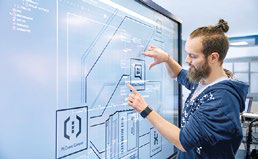By Gareth Smith,
Organizations are increasing the adoption of intelligent automation to deliver efficiencies and free up resources. These solutions are applied to different tasks in industries, providing Artificial Intelligence (AI) fundamental capabilities. Automation aims to create processes that think, learn and adapt independently, and for technology to replace humans in performing repetitive tasks through intelligent software robots.
AI-powered automation will deliver tangible benefits to businesses, and in a primarily digital world, the need and demand will continue to grow. By 2024, Gartner estimates that organizations will reduce their operating costs by 30 percent by combining hyper-automation technologies with redesigned operational processes.
One area that is being transformed by intelligent automation is software testing. Many organizations around the world are using the Keysight Technologies platform to understand and meet customer demands. To learn more about intelligent automation, we asked Dr. Gareth Smith, General Manager of Test Software Automation at Keysight to share his point of view.
What is intelligent automation?
The concept of intelligent automation applies innovative technologies such as AI, machine learning (ML), and robotic process automation (RPA) to scale and streamline decision making and processes to deliver greater operational efficiency. AI helps in the automation process to deliver better results faster.
How is intelligent automation transforming software testing?
Intelligent automation uses technologies such as AI to assess systems and to automatically generate previously resource-intensive elements (such as scripts), analyze the results to predict software failures, and adjust automation logic to improve coverage. of testing and overall quality. This is a profound change compared to the test environment of a few years ago. Back then, software testing was seen as a box-pushing activity to ensure that a system or product passed predefined and usually static tests. Manual testing provides the “intelligence” but is too slow for modern systems and not as comprehensive, so it's obsolete, and there are more effective ways to use your workforce. Similarly, traditional test automation did not incorporate smart technologies and relied on running the same script every time new software was released. These approaches failed to find new bugs, did not proactively search for weak points in the system, and lacked the intelligence to identify what is a critical test from the user's point of view, so it was common for manual testing to be necessary in supplement with them.
In a digitally dependent world, it is no longer enough to rely only on verifying that a system meets your requirements. Instead, organizations must be able to validate that their solutions meet the needs of users; it is essential to understand and calibrate the digital user experience. This requires continuous testing of the actual user experience across all touch points, browsers, devices, and systems. And the only way to do this is by integrating intelligent technologies that automate testing from the user's perspective and obtain the necessary information to optimize the user experience.
Intelligent automation is like unleashing an army of AI-powered robots into applications, websites, and processes that behave like real users and explore (and experience) workflows (or user journeys) just like real users would. Automation needs to go beyond functional testing and merge performance and usability aspects. This speeds the output of high-quality software because you can find significant problems and defects in these real-world streams. The result is a smarter, more cost-effective way to continuously test software and applications.
What is the role of AI in intelligent automation?
AI makes it easy for testing to go beyond simple rule-based automation. It uses algorithms to efficiently train systems using huge data sets (and there's a ton of data available in the testing world). It can emulate human behavior through application reasoning and problem solving, and it works by running automated test routines. And it can mimic human behavior through application reasoning and problem solving, and it works by running automated test routines that mirror the actions of real human users. The AI hunts down UI errors, bugs, and feature failures and then automatically fixes problems before they can impact the user experience.
Automation increases coverage by considering all potential user journeys and predicting and identifying any bottlenecks that may affect performance. As the AI algorithm learns, it continually improves the quality of system and software performance, providing a competitive advantage.
Tell us more about how intelligent test automation helps organizations deliver a user experience that meets their expectations
Intelligent automation allows companies to understand the software in the same way as the user. Below are three examples of how Keysight clients are taking advantage of our platform.
NASA uses intelligent test automation in the Orion space program to ensure that onboard hardware and software work as expected and are fault-free. By developing intelligent automation, NASA can accelerate the delivery and quality of its complex, high-quality, mission-critical software system.
Oxford University Hospitals NHS Foundation Trust is world renowned for excellence in healthcare, training and research. You've trusted Keysight to intelligently perform automated regression testing, complete training domains, schedule appointments, and add patient observations. The reliability, predictability, and consistency of automation have helped the hospital improve its productivity and speed up the pace of testing.
The FUJIFILM group turned to Keysight to automate the testing of their embedded software in medical devices. The platform made it easy for them to achieve efficiencies and ensure a reliable, high-quality product.
Do organizations need more IT or Technical resources to manage intelligent automation?
Another benefit of intelligent automation is its ease of use. Many of the solutions, such as Keysight's, are low-code or no-code, so they don't require programming expertise to use or manage automation efforts.
What are the general benefits of intelligent automation?
There are many benefits that organizations, regardless of industry, can expect from intelligent automation integration. Some of the main ones are:
- Reduce costs: by automating systems and processes it is easier and faster to scale them
- Increases accuracy: AI guides decision making and provides a consistent approach to routine tasks by removing human limitations
- Improve the digital user experience: intelligence improves the quality of products by improving the user experience
How does intelligent automation help when the software and application are published?
Once software is released, organizations need a way to continuously monitor its performance in order to identify and fix problems that may occur. Intelligent automation can be extended to production to test in these environments in the same way that it does in development, but in this case to obtain information from the real world. An obvious place to start is to look at what parts of the system work fine in the lab but not in production. AI can perform and understand real 'customer journeys', highlighting the most used and highest value elements and flows ('user journeys') throughout the production system. This information can then be used to prioritize and guide testing toward improving the overall experience and quality for real users.
What can we expect from intelligent automation in the coming years?
Very few systems or organizations are getting simpler or slowing down. The growing range of facets of any digital organization grows in number and variety. And on top of that, the need to be faster and more agile means that an intelligent automation platform is the only way to keep up with innovation and deliver quality of experience to users and customers. Those organizations that do not adopt it will have a hard time staying competitive. Intelligent automation will continue to evolve to provide a platform for future organizations to optimize available resources to meet the growing demand for quality and added value that differentiates offerings and is more relevant to the overall business.








